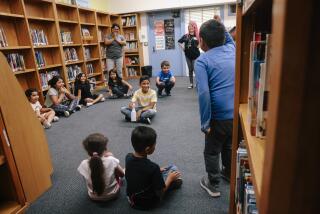Lease on Learning for Motel Kids
Before going to sleep, Jack Bennett makes sure his four children are dressed--not for bed, but for school.
For the single father and his children--Crystal, 8, Jack Jr., 6, and twins Jasmine and Natalie, 5--getting everyone ready in their small room with two beds at the Anaheim Eagle Inn and Suites is a daily struggle. To save time, the kids shower and dress the night before.
School itself has been a struggle for the children, who have bounced from motel to motel since the family was evicted from an Anaheim apartment more than a year ago, their father said. Thanks to the Homeless Outreach Program in Education, though, the Bennetts and dozens of other youngsters have an academic safety net.
Project HOPE, the only school of its kind in Orange County, provides instruction for 54 homeless children in kindergarten through eighth grade. The safety net is expected to widen when child-care services are made available at a Fullerton College center in Anaheim, which opens early next year. Public schools soon will have to develop plans to help such children under a new federal law.
For now, though, each weekday, a yellow school bus plies the motel rows of Anaheim, Buena Park, Garden Grove and Santa Ana to ferry the kids to and from the First Presbyterian Church of Orange, where three teachers instruct the children, who are divided into three classrooms. Some kids come from as far away as Irvine and San Juan Capistrano, dropped off by parents or grandparents and mostly living in cars.
Educators and parents said the schoolâs smaller classes allow for individual attention, continuity and a more nurturing environment for the children--many of whom have bounced from school to school, even district to district--as their parents have struggled to find housing.
When Crystal Bennett started at the school a year ago, she couldnât read. Within eight months, her father said she was reading Dr. Seuss books to him.
âI really like my teachers and my friends because they are so nice,â said Crystal.
Project HOPE was founded in 1989 by the county Department of Education. At first, informal classes were held in parking lots and motels. It has evolved into a fully functioning facility.
The state and county education departments cover $320,000 for teacher salaries, materials and other costs. Busing this year is costing about $70,000, paid for through the county social services agency and donations. The church underwrites much of the program by charging $2 a month for its facilities.
Transportation is one of the programâs biggest hurdles because county social services funds wonât be available, principal Tony Gibson said.
âWithout transportation there is no Project HOPE,â Gibson said. âBut if the kids canât come to us, we will come to them somehow.â
The number of homeless has spiked 17% in the last year, according to county records. And 16,000 of the estimated 23,000 homeless people in the county are parents and their children.
Motel families can be found across Orange County, but Karen Roper, the countyâs coordinator for homeless programs, said people tend to gravitate toward Anaheim and Buena Park, and other cities in the north and central part of the county with many motels.
In recent years, some Orange County cities such as Anaheim and Santa Ana have tried to limit motel stays, which means people switch motels or rooms within motels frequently. The impact on children can be harsh.
âThe biggest trauma and pressure for kids is just having to move around so much,â Roper said. âThey have no relationships and are sometimes so behind in school, itâs just tragic.â
Project HOPE tries to ease the upheaval.
As they surfed the Internet for information on medieval culture during a recent morning computer session, 20 fifth-to eighth-graders beamed with excitement.
âThis school is a lot more fun,â said eighth-grader Karen Gillespie, 13, who has been at the school for five years. âSome kids at other schools were mean.â
Educators say the pressures of an unstable family life and derision of peers can cause some homeless children to withdraw.
âSometimes homeless kids become the target of their peers because they donât necessarily have the best clothes,â principal Gibson said. âThe children find comfort in being around others who are going through the same experience.â
When children first come to the school, teachers assess their skills. While theyâd like them to catch up to grade level and return to regular school, that isnât always possible if a familyâs finances remain unstable.
For the Bennetts, it means dad gets up at 5:15 a.m., the children at 6 a.m. to put on socks and shoes before he drops them at a nearby motel where their mom lives.
Sue Bennett, 31, puts them on the bus at 7:30 a.m. and meets them in the afternoon. Jack Bennett collects them after working as lead stock clerk at a computerized lock-making company.
âIâm not going to lie and say that itâs been easy,â Jack Bennett said. âBut I try to keep it from them and just try to get them out of here.â
More to Read
Sign up for Essential California
The most important California stories and recommendations in your inbox every morning.
You may occasionally receive promotional content from the Los Angeles Times.










